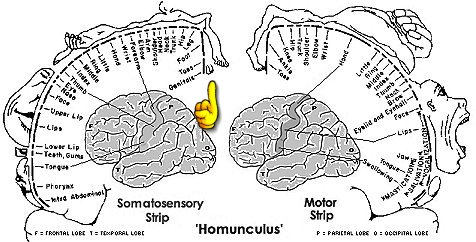The septum has been called the brain's 'pleasure center'. It's
a part of the limbic system, where it operates in tandem with the amygdala. When one of these is active, the other
tends to be quiet. The septum is heavily connected to the hippocampus, a structure which is intergrown with the
amygdala.
The centers for orgasm (four for women and one for men) are
found in the septum. It has been associated with different kinds of pleasant sensations, mainly those related to
sexual experiences. The septum's role in quieting the amygdala explains how sexual desire can overwhelm our emotional
awareness. The septum's one 'orgasm center' in men, and four in women, suggests that there may be important differences
in this signal's effects for men and women.
One study found that when patients were implanted with septal
electrodes, they self stimulated themselves only when they were feeling bad. When they were feeling good, the implants
had little effect.
The temporal lobes, the parietal lobes, and the frontal lobes
are all good candidates for this signal, but the place that most lends itself to this signal is over the tops of
both parietal lobes, where the somatosensory (sensation) representation for the genitals is located.
The septum's close association with the hippocampus is seen
in both their anatomical connections and their EEG signatures. Both the septum and the hippocampus produce theta
band output in their normal functioning. Shakti's hippocampal signal is almost always more pleasant over the right
side, so if you are going to use this septal signal over one side only, the right is the best candidate.
|

|
|
|
The yellow pointer shows the location.
|
The fields run between the coils, with the inside top portion of the parietal
lobes included.
|
When beginning to use any signal, it's a good idea to begin
with shorter sessions.